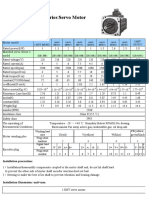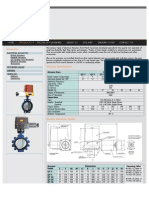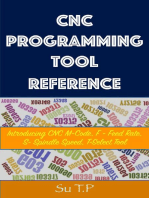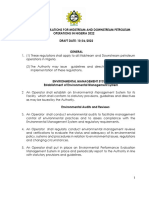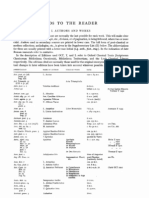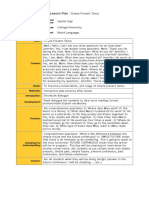AI152986482525en 000404
AI152986482525en 000404
Uploaded by
Saeed MahmoudabadiCopyright:
Available Formats
AI152986482525en 000404
AI152986482525en 000404
Uploaded by
Saeed MahmoudabadiOriginal Title
Copyright
Available Formats
Share this document
Did you find this document useful?
Is this content inappropriate?
Copyright:
Available Formats
AI152986482525en 000404
AI152986482525en 000404
Uploaded by
Saeed MahmoudabadiCopyright:
Available Formats
Data Sheet
Transmission Module
PVBM
Meter-In Meter-Out – Open Circuit Transmission
The Meter-in Meter-out module is designed primarily
for use with transmission hydraulic motors in e.q.
manlifts or demanding winch applications. The terms
Meter-In and Meter- Out relates to the oil flow being
metered into (Meter-In) and out from (Meter-Out) the
transmission motor by the PVG valve.
With the Meter-in Meter-out module both flows in
and out of the transmission motors are controlled at
the same time.
The Meter-in Meter-out module will ensure a stable,
well controlled movement of application when motor
is pushing (i.e. upwards hill) or motor being pulled
(i.e. downward hill) or horizontal movement.
Features
• Integrated shock/anti-cavitation valve
(A- and B- port)
• T0 connection
• BSP/UNF
• Meter-In compensator
• Meter-Out compensator on A- and B-
port
• Increased control of negative loads
Comprehensive technical literature online
at powersolutions.danfoss.com
© Danfoss | Mar 2017 L1117392 | AI00000124en-US0303 | 1
Data Sheet
Transmission Module PVBM
Schematic
Available spools
A B
Flow Function in Flow l/min Part Number
Characteristic Neutral (Symmetrical)
Progressive Closed neutral 5 11187198
10 11185988
25 11186235
40 11186436
65 11186450
T0
100 11156265
130 11156268
Linear Closed neutral 10 11187177
25 11187390
LS 40 11187500
65 11187659
T P
V310 310.A
100 11156300
Available modules
Description BSP G1/2 ports Code SAE 7/8-14 ports
No. Code No.
PVBM module 157B6268 11018399
Application Awareness
• With the Meter-In Meter-Out module, stability is determined by ensuring that oil flow into the system is always lower than oil flow out
of the system. This is achieved by means of different spring settings in the Meter-In Meter-Out compensators. As an example, this
means that a motor will run faster in Meter-Out mode than in Meter-In mode.
• Due to the Meter-out compensators, a backpressure valve is needed to avoid cavitations when running in meter-out situations. The
back pressure setting would be application dependent but typical values are between 5-10 bar. Increased back pressure setting
ensures better protection against cavitations but also decrease energy efficiencies. The hydraulic system would be leaking in neutral
when external forces acts on the working ports. To avoid unwanted movements of the applied motors, therefore external brakes are
needed.
• Dependent on the application type smooth movement could be requested. PVE’s in combination with a controller and joystick could
be useful to add ramps on the spool and delay on the motor brakes so it doesn’t hit the brakes too hard when returning to neutral.
2 | © Danfoss | Mar 2017 L1117392 | AI00000124en-US0303
Data Sheet
Transmission Module PVBM
Technical specifications
Max. pressure Port P continuous, Port A/B 350 bar [5076 psi]
Port T static/dynamic 25/40 bar [362/580 psi]
Port A/B and P 130 l/min [34 US gal/min]
Oil flow, rated Port A/B and P 130 l/min [34 US gal/min]
Spool travel ±7 mm [±0.28 in]
Max. internal leakage A/B→T at 100 bar [1450 psi] and 21 mm2/s 1 l/min [61 in3/min]
Max. internal leakage A/B→T at 200 bar [2900 psi] and 21 mm2/s 1.5 l/min [92 in3/min]
Oil temperature (inlet) Recommended 30 → 60 °C [86 → 140°F]
Minimum -30 °C [-22 °F]
Maximum 90 °C [194 °F]
Ambient temperature -30 → 60 °C [-22 → 140 °F]
Oil viscosity Operating range 12-75 mm2/s [65-347 SUS]
Minimum 4 mm2/s [39 SUS]
Maximum 460 mm2/s [2128 SUS]
Filtration, max. contamination (ISO 4406) 18/16/13
© Danfoss | Mar 2017 L1117392 | AI00000124en-US0303 | 3
Danfoss can accept no responsibility for possible errors in catalogues, brochures and other printed material. Danfoss reserves the right to alter its products without notice. This also applies to products
already on order provided that such alterations can be made without changes being necessary in specifications already agreed.
All trademarks in this material are property of the respective companies. Danfoss and the Danfoss logotype are trademarks of Danfoss A/S. All rights reserved.
4 | © Danfoss | Mar 2017 L1117392 | AI00000124en-US0303
You might also like
- Operation Manual: Pile Driver DPD 350Document31 pagesOperation Manual: Pile Driver DPD 350Joseph Emmanuel Paredes100% (1)
- Item:130ST Series Servo Motor: SpecificationsDocument4 pagesItem:130ST Series Servo Motor: Specificationsn13t0314No ratings yet
- HDB BreakersDocument89 pagesHDB BreakersJohn Louie Mazon100% (6)
- 356908-Prac Tool - Mood Diary WorksheetDocument2 pages356908-Prac Tool - Mood Diary WorksheetCvetanka BurzevskaNo ratings yet
- AI152986482525en 000404Document4 pagesAI152986482525en 000404Sukoco EgiNo ratings yet
- Gear Motors: Solid and ReliableDocument8 pagesGear Motors: Solid and ReliableAlexis BriseñoNo ratings yet
- SFIDKPI026A352Document24 pagesSFIDKPI026A352oscarcito08No ratings yet
- Electromagnetic Flowmeter Upser Manual External PoweredDocument33 pagesElectromagnetic Flowmeter Upser Manual External Poweredevct1989No ratings yet
- GOOD JACK UnlockedDocument4 pagesGOOD JACK UnlockeddolensiallaganNo ratings yet
- HSP_ENDocument16 pagesHSP_ENAlvin NgNo ratings yet
- Elevator Control Valves: EN ISO 9001Document4 pagesElevator Control Valves: EN ISO 9001Bantu BantuNo ratings yet
- 78-00452_profo_clearpoint_v_4p_int_v01_display (1)Document4 pages78-00452_profo_clearpoint_v_4p_int_v01_display (1)karpagamthavakudliNo ratings yet
- GAC1000Document7 pagesGAC1000HienNo ratings yet
- DS STG 2040 2080 Actuator eDocument2 pagesDS STG 2040 2080 Actuator ebrichtrNo ratings yet
- Lenze SMD Frequency Converter DatasheetDocument8 pagesLenze SMD Frequency Converter DatasheetCHAREFNo ratings yet
- Water Meter PDFDocument2 pagesWater Meter PDFHerry Bagus Cah MbelinkNo ratings yet
- nc150s Isuzu 4le2x Us 200gpa0001420 - Us PDFDocument2 pagesnc150s Isuzu 4le2x Us 200gpa0001420 - Us PDFjuanpantera24No ratings yet
- Clutch Cable PDFDocument4 pagesClutch Cable PDFVEERAMANINo ratings yet
- Actuator SpecsDocument2 pagesActuator SpecstranceyamunaNo ratings yet
- HDB BreakersDocument88 pagesHDB Breakersmargotsilva96No ratings yet
- Airmax Pneumatic Cylinder Anc VNCDocument32 pagesAirmax Pneumatic Cylinder Anc VNCManoj DoshiNo ratings yet
- Model LWGY: Turbine Flow TransducerDocument5 pagesModel LWGY: Turbine Flow Transducernew587No ratings yet
- A6VM Series 6 Motor PDFDocument76 pagesA6VM Series 6 Motor PDFSebastián Fernando Canul MendezNo ratings yet
- Spec - Canter 6.5 Doble Cabina FEB71EL4WNQCDocument7 pagesSpec - Canter 6.5 Doble Cabina FEB71EL4WNQCDiego Andres Rojas RamirezNo ratings yet
- C 传动装置 C Transmission UnitDocument16 pagesC 传动装置 C Transmission UnitJOAO BIANCHININo ratings yet
- Eaton Clutch Selector Chart Technical Data Sheet enDocument2 pagesEaton Clutch Selector Chart Technical Data Sheet enHimanshu SharmaNo ratings yet
- Eaton Heavy-Duty Clutch SelectorDocument2 pagesEaton Heavy-Duty Clutch SelectorFlavio EdisonNo ratings yet
- Motor SelemaDocument7 pagesMotor SelemaAhmed Abd elhafezNo ratings yet
- Marathon LDocument16 pagesMarathon LmohamedNo ratings yet
- Takeuchi Tb035 Partsmanual Sec WatDocument20 pagesTakeuchi Tb035 Partsmanual Sec WatRichard100% (69)
- CATALOGO Generale VMC PDFDocument32 pagesCATALOGO Generale VMC PDFMaciekLembryk100% (1)
- RDAB10S - Actuador para Damper 10 NM 24 240vDocument2 pagesRDAB10S - Actuador para Damper 10 NM 24 240vgiovanniNo ratings yet
- Airman SC Series - Screw Compressors: Model CompressorDocument2 pagesAirman SC Series - Screw Compressors: Model CompressorMichaelNo ratings yet
- HY62V8100B (Rev13) PDFDocument12 pagesHY62V8100B (Rev13) PDFsmhzzNo ratings yet
- 01 4TNV98T-ZCSTY 规格参数表-英文Document4 pages01 4TNV98T-ZCSTY 规格参数表-英文Eric CNo ratings yet
- Lighting tower selection chart-20191107Document2 pagesLighting tower selection chart-20191107rifatha693No ratings yet
- Indian RailwaysDocument23 pagesIndian RailwaysRAYNo ratings yet
- Hook Suspended Pneumatic Chain HoistDocument6 pagesHook Suspended Pneumatic Chain HoistsriguruprasathsNo ratings yet
- gui00011Document24 pagesgui00011f GoingNo ratings yet
- Gassense Ndir Sensor ManualDocument11 pagesGassense Ndir Sensor ManualSửa Thiết BịNo ratings yet
- A Polyhydron Group Company: DescriptionDocument2 pagesA Polyhydron Group Company: DescriptionRenjithSivaNo ratings yet
- Clorius Actuator CARDocument4 pagesClorius Actuator CARCatalin BeuNo ratings yet
- Enersys Powerbloc GB - EnerSys-HawkerDocument8 pagesEnersys Powerbloc GB - EnerSys-HawkerAndrás TóthNo ratings yet
- Manual Straightline Type D-1Document25 pagesManual Straightline Type D-1Murat AltparmakNo ratings yet
- Manual 3ph SMDDocument8 pagesManual 3ph SMDindikalk100% (2)
- LAPP KabelDocument3 pagesLAPP Kabeljosip miskovicNo ratings yet
- SAFMAG Beta Meter Data SheetDocument3 pagesSAFMAG Beta Meter Data Sheetvalentine misanaNo ratings yet
- PX 55 Flow Component - ValveDocument64 pagesPX 55 Flow Component - ValveKal JNo ratings yet
- Crouzet Valve ManualDocument12 pagesCrouzet Valve ManualvikashyadavNo ratings yet
- Ducted Split: LG Air ConditionersDocument100 pagesDucted Split: LG Air Conditionersjose antonioNo ratings yet
- HDB Breakers ManualDocument89 pagesHDB Breakers ManualJoseph Emmanuel ParedesNo ratings yet
- Man 7g50meDocument18 pagesMan 7g50meSalih Tuğrul Sarı100% (1)
- ATS Daco KoreaDocument12 pagesATS Daco Koreaelmotoci0% (1)
- LS200 HDDocument3 pagesLS200 HDMartin LorenzattoNo ratings yet
- Exide Marathon M-FT DatasheetDocument10 pagesExide Marathon M-FT Datasheetsajeevanreshma07No ratings yet
- Sensors Worldwide: BTL5-P/I/K/L/M - M/U - P-S 32/KA - Micropulse Linear Transducer Digital Output / Profile HousingDocument12 pagesSensors Worldwide: BTL5-P/I/K/L/M - M/U - P-S 32/KA - Micropulse Linear Transducer Digital Output / Profile HousingKamel NaimiNo ratings yet
- Flow Daniel DAN-1500-LIQ-TM-PG-0824Document22 pagesFlow Daniel DAN-1500-LIQ-TM-PG-0824elinstwhrpgNo ratings yet
- FMP Prospekt PB-XFC EnglishDocument8 pagesFMP Prospekt PB-XFC Englishparahu ariefNo ratings yet
- ReportDocument1 pageReportSaeed MahmoudabadiNo ratings yet
- BC152886482382en 000404Document12 pagesBC152886482382en 000404Saeed MahmoudabadiNo ratings yet
- Semperit DINEN8571SCDocument1 pageSemperit DINEN8571SCSaeed MahmoudabadiNo ratings yet
- EN 857 1SC ISO 11237-1: Hose Size R.O.D. O.D. Max W.P. Burst Pressure Min. Bend Radius WeightDocument1 pageEN 857 1SC ISO 11237-1: Hose Size R.O.D. O.D. Max W.P. Burst Pressure Min. Bend Radius WeightSaeed MahmoudabadiNo ratings yet
- NG 910CV11 04 00 (Rev00)Document4 pagesNG 910CV11 04 00 (Rev00)Saeed MahmoudabadiNo ratings yet
- 25 RandomthingsDocument1 page25 Randomthingsrzbackup1426No ratings yet
- 3a. The Coastal ZoneDocument140 pages3a. The Coastal Zoneb_osborne100% (1)
- Chapter 1 Global Marketing ManagementDocument30 pagesChapter 1 Global Marketing ManagementAdiba AnisNo ratings yet
- Environmental Regulations For Midstream and Downstream Operations DraftDocument17 pagesEnvironmental Regulations For Midstream and Downstream Operations DraftAmaksNo ratings yet
- Magnetrol Tuning ForkDocument28 pagesMagnetrol Tuning ForkEdwin MercadoNo ratings yet
- GulfSea Synth Gear Oil PG220Document2 pagesGulfSea Synth Gear Oil PG220Md.Obydur RahmanNo ratings yet
- Lsat GuideDocument173 pagesLsat Guidemslavkovich100% (4)
- Module 1 - Introduction To ICTDocument17 pagesModule 1 - Introduction To ICTciapadlanNo ratings yet
- Bottle Blowing & FillingDocument14 pagesBottle Blowing & Fillingmichael odiemboNo ratings yet
- Hilti. Outperform. Outlast: If You Are An Existing User - Submit Activation KeyDocument1 pageHilti. Outperform. Outlast: If You Are An Existing User - Submit Activation KeySAN HTET AUNGNo ratings yet
- Trayectorias Profesionales - Arquitecto (INTJ) Personalidad - 16personalidadesDocument5 pagesTrayectorias Profesionales - Arquitecto (INTJ) Personalidad - 16personalidadesjorge de la vegaNo ratings yet
- Bibliography Writing: Research Methodology CourseDocument9 pagesBibliography Writing: Research Methodology Courselahcen aouarNo ratings yet
- Math Test (Part 1) Answer KeyDocument4 pagesMath Test (Part 1) Answer KeyCharles CarulloNo ratings yet
- Analysis of Demat Account & Online Trading Karvy Stock Brocking Limited (M.Com Project)Document64 pagesAnalysis of Demat Account & Online Trading Karvy Stock Brocking Limited (M.Com Project)VRUKSHITNo ratings yet
- 2020-2023 Pay Increases Local 308Document1 page2020-2023 Pay Increases Local 308Chicago Transit Justice CoalitionNo ratings yet
- Micropara Prelim CompilationDocument13 pagesMicropara Prelim CompilationNathaniel BudayNo ratings yet
- Minor ProjectDocument10 pagesMinor ProjectvangalabhanupriyaNo ratings yet
- Obturator Prosthesis To Rehabilitate Maxillary Defect On Cleft Palate and Kennedy Clas Iii PatientDocument7 pagesObturator Prosthesis To Rehabilitate Maxillary Defect On Cleft Palate and Kennedy Clas Iii Patientafifah nabilahNo ratings yet
- Computer ArchitecturDocument6 pagesComputer ArchitecturechandanaNo ratings yet
- Books For Children Beginning To ReadDocument19 pagesBooks For Children Beginning To ReadTeresa MagalhãesNo ratings yet
- Abreviaturas de Autores ClásicosDocument15 pagesAbreviaturas de Autores ClásicosNoemiGSNo ratings yet
- OECD Budgeting in Chinese TaipeiDocument31 pagesOECD Budgeting in Chinese TaipeiCristian Pablo Yáñez NavarroNo ratings yet
- MATLAB Quick GuideDocument126 pagesMATLAB Quick GuideAmit KumarNo ratings yet
- Sunder CFT Column ReportDocument33 pagesSunder CFT Column Reportsunder kumawatNo ratings yet
- ABM ReviewerDocument7 pagesABM ReviewerMaria Francheska GarciaNo ratings yet
- STAT170 Research 3Document4 pagesSTAT170 Research 3Biyan HariyantoNo ratings yet
- CEPC+116-+Lesson+10 Fluid+Flow+in+PipesDocument19 pagesCEPC+116-+Lesson+10 Fluid+Flow+in+PipesLorence LatorzaNo ratings yet
- Lesson Plan:: Teacher Name: Grade: SubjectDocument2 pagesLesson Plan:: Teacher Name: Grade: SubjectViennaDumaganNo ratings yet
- An Introduction To Investment Appraisal: The Initial Outlay For That InvestmentDocument4 pagesAn Introduction To Investment Appraisal: The Initial Outlay For That Investmentalmasmalik296No ratings yet


